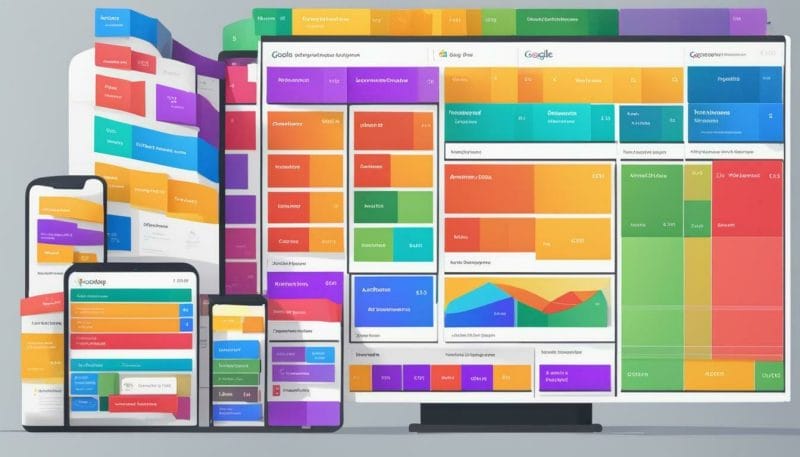Confused about whether you pay for impressions on Google Ads? We’ve got answers. Loudachris Digital Marketing is here to assist you with all your advertising needs. With our expertise in Google Ads, we can help you navigate the world of paid search advertising and optimise your ad performance.
- Google Ads offers different pricing models, including cost-per-click and cost-per-impression.
- Targeted advertising allows businesses to reach the right audience at the right time.
- Tracking ad performance is crucial for optimising return on investment (ROI).
- Google Ads provides flexible pricing options to suit various budget requirements.
- Reaching a wide audience through Google Ads can expand brand visibility.
Understanding Google Ads Pricing Models
When it comes to advertising on Google Ads, it’s important to understand the various pricing models and how they can affect your budget. Google Ads offers different pricing models to accommodate the needs and goals of businesses, whether they are looking to drive website traffic, increase conversions, or raise brand awareness.
One of the most popular pricing models in Google Ads is the cost-per-click (CPC) model. With CPC, advertisers only pay when someone clicks on their ad. This model is ideal for businesses that want to drive traffic to their website and are willing to pay for each click. The cost per click can vary depending on factors such as keyword competitiveness and ad relevance.
Another pricing model offered by Google Ads is the cost-per-impression (CPM) model. With CPM, advertisers pay for every 1,000 impressions their ad receives, regardless of whether or not someone clicks on it. This model is suitable for businesses that want to increase brand visibility and reach a wide audience. CPM pricing can vary depending on factors such as targeting options and ad placement.
It’s important to note that the choice between CPC and CPM pricing models depends on your advertising goals and budget. If your goal is to drive website traffic and conversions, CPC may be the better option. On the other hand, if your goal is to increase brand awareness and reach a wide audience, CPM may be more suitable. Working with a digital marketing agency like Loudachris can help you navigate the different pricing models and optimise your ad campaign for maximum results.
Table 1: Comparison of CPC and CPM Pricing Models
| Pricing Model | Key Features | Best Suited for |
|---|---|---|
| Cost-Per-Click (CPC) | Pays for each click on the ad | Driving website traffic and conversions |
| Cost-Per-Impression (CPM) | Pays for every 1,000 ad impressions | Increasing brand visibility and reaching a wide audience |
Understanding the pricing models offered by Google Ads is crucial for optimising your advertising budget and achieving your marketing goals. Whether you choose CPC or CPM, it’s essential to monitor your ad performance, track conversions, and make data-driven decisions to maximise your return on investment. Loudachris Digital Marketing can provide expert guidance in leveraging Google Ads pricing models and help you achieve better results for your business.

Google Ads offers businesses the option to pay either based on the number of clicks their ads receive or the number of impressions their ads generate. Understanding the difference between cost-per-click (CPC) and cost-per-impression (CPM) is crucial for businesses looking to optimise their advertising budget and reach their target audience effectively.
With cost-per-click advertising, businesses only pay when a user clicks on their ad. This pricing model is ideal for driving immediate website traffic and generating conversions. It allows businesses to measure the direct impact of their ads and focus on boosting click-through rates. However, it’s important to note that not all clicks lead to conversions, so monitoring and optimising ad performance is essential to ensure a positive return on investment.
On the other hand, cost-per-impression advertising charges businesses for every 1,000 ad impressions their ads receive. This pricing model is beneficial for businesses seeking to build brand awareness and reach a wide audience. It allows for greater visibility and exposure, even if users don’t click on the ad. Cost-per-impression can be a cost-effective strategy, especially when aiming to create brand recognition and increase brand recall.
To determine the best pricing model for your business, it’s important to consider your advertising goals, target audience, and budget. Loudachris Digital Marketing can help you analyze your specific needs and develop a tailored Google Ads strategy that maximises your advertising investment.

Both cost-per-click and cost-per-impression have their advantages depending on your business objectives. Cost-per-click allows for precise targeting and immediate conversions, making it ideal for e-commerce businesses or those with specific lead generation goals. On the other hand, cost-per-impression can be a cost-effective way to increase brand visibility and create a lasting impression among your target audience.
Using a combination of these pricing models can help optimise your Google Ads campaign by targeting different stages of the customer journey. By utilising cost-per-click for direct response ads and cost-per-impression for brand awareness campaigns, you can maximise your reach and generate a higher return on investment.
Summary
In conclusion, Google Ads offers businesses the flexibility to choose between cost-per-click and cost-per-impression pricing models. Understanding the difference between these models is essential to develop an effective advertising strategy. By partnering with Loudachris Digital Marketing, you can leverage the expertise needed to navigate the world of Google Ads and optimise your ad performance.
| Pricing Model | Objective | Advantages |
|---|---|---|
| Cost-Per-Click (CPC) | Immediate conversions, precise targeting | Measurable impact, higher click-through rates |
| Cost-Per-Impression (CPM) | Brand visibility, wide audience reach | Cost-effective, increased brand recognition |
Leveraging Targeted Advertising for Better Results
By leveraging targeted advertising on Google Ads, businesses can ensure their ads are shown to the most relevant audience, maximising the chances of converting leads. Targeted advertising allows you to narrow down your audience based on factors such as demographics, interests, and search behavior. This means that your ads will only be displayed to people who are most likely to be interested in your products or services, increasing the effectiveness of your advertising campaigns.
One of the key advantages of targeted advertising is its cost-effectiveness. Instead of showing your ads to a broad audience, targeting specific demographics or interests allows you to allocate your advertising budget more efficiently. This means that you can focus your spending on the people who are most likely to convert, reducing wasted ad spend and increasing your return on investment.
Another benefit of targeted advertising is the ability to personalise your messaging to specific audience segments. By tailoring your ads to resonate with the interests and needs of your target audience, you can significantly increase engagement and drive more conversions. This can be achieved by using unique messaging that speaks directly to the pain points and desires of your target audience, making your ads more relevant and compelling.
Example Table: Target Audience Interests
| Target Audience | Interests |
|---|---|
| New Parents | Baby products, parenting advice |
| Tech Enthusiasts | Gadgets, latest technology trends |
| Fitness Enthusiasts | Gym memberships, workout equipment |
By utilising targeted advertising features in Google Ads, businesses can optimise their ad campaigns to reach the right audience at the right time. This not only increases the chances of converting leads but also enhances the overall user experience by delivering relevant and useful ads. With the help of Loudachris Digital Marketing, you can navigate the world of Google Ads and make the most of its targeting capabilities to drive better results for your business.

Remember, the key to successful targeted advertising is understanding and defining your target audience. Conduct market research, analyze consumer behavior, and develop detailed customer profiles to identify the interests, demographics, and online behaviors of your target audience. This information will help you create compelling ads that resonate with your audience and maximise your advertising budget.
Tracking Ad Performance and Maximising ROI
Monitoring ad performance is crucial for understanding the effectiveness of your Google Ads campaigns and maximising your ROI. At Loudachris Digital Marketing, we provide expert guidance on tracking ad performance and optimising your advertising costs.
One effective way to track ad performance is by utilising the data provided by Google Ads. By analyzing metrics such as click-through rates (CTR), conversion rates, and average cost per click (CPC), you can gain valuable insights into the performance of your ads. These metrics help you understand how well your ads are resonating with your target audience and how effectively they are driving conversions.
In addition to monitoring ad performance, it is important to optimise your ad campaigns to maximise your ROI. This can be achieved by continuously testing and refining your ads to improve their effectiveness. By conducting A/B tests, you can compare different variations of your ads to identify which ones perform best. You can also optimise your ad targeting to reach specific audiences that are more likely to convert.

| Metrics | Objective |
|---|---|
| Click-through Rate (CTR) | Measure the percentage of users who clicked on your ad after seeing it. |
| Conversion Rate | Track the percentage of users who completed a desired action on your website after clicking on your ad. |
| Average Cost per Click (CPC) | Calculate the average amount you are paying for each click on your ads. |
By tracking ad performance and optimising your Google Ads campaigns, you can ensure that your advertising budget is being used effectively and generating the best possible results. At Loudachris Digital Marketing, we have the expertise to help you navigate the complexities of Google Ads and maximise the return on your investment.
Remember, tracking ad performance is just the first step. It is equally important to analyze the data and make informed decisions based on the insights gained. By continuously monitoring and optimising your Google Ads campaigns, you can drive better results, increase conversions, and achieve a higher ROI.
Flexible Pricing Options to Suit Your Budget
Google Ads offers businesses the flexibility to set their own budgets and adjust their advertising costs according to their financial capabilities. Whether you are a small startup or a well-established company, Loudachris Digital Marketing can help you navigate the world of Google Ads and make the most of your advertising budget.
With Google Ads, you have the freedom to choose how much you want to spend on your campaigns. You can set a maximum daily budget to ensure that you never spend more than you can afford. This allows you to test different strategies and see what works best for your business without worrying about breaking the bank.
Additionally, Google Ads offers different bidding strategies that allow you to control how your budget is allocated. You can choose to pay based on cost-per-click (CPC), where you only pay when someone clicks on your ad, or cost-per-impression (CPM), where you pay based on the number of impressions your ad receives. By understanding the differences between these pricing models, Loudachris Digital Marketing can help you make informed decisions that maximise your return on investment.
At Loudachris Digital Marketing, we understand that every business is unique and has different advertising goals. Our team of experts will work closely with you to develop a customised Google Ads strategy that aligns with your budget and objectives. We will optimise your campaigns, target specific audiences, and track ad performance to ensure that you are getting the most out of your advertising budget.
Table: Google Ads Pricing Comparison
| Pricing Model | Payment Structure | Advantages |
|---|---|---|
| Cost-Per-Click (CPC) | You pay when someone clicks on your ad | Control over your budget, pay only for engagement |
| Cost-Per-Impression (CPM) | You pay based on the number of impressions your ad receives | Increased brand visibility, reach a larger audience |

With Loudachris Digital Marketing by your side, you can take advantage of the flexible pricing options offered by Google Ads. We will help you understand the pricing models and create a tailored strategy that suits your budget and business goals. Contact us today to get started on your Google Ads journey!
The Power of Reaching a Wide Audience
With Google Ads, businesses can gain extensive exposure by reaching a vast audience across various online platforms. Paid search advertising allows you to target specific demographics, interests, and locations, ensuring your ads are seen by the right people at the right time. This targeted approach maximises the effectiveness of your advertising budget, increasing the chances of converting leads into customers.
By utilising Google Ads’ PPC (pay-per-click) advertising model, you only pay when someone clicks on your ad, ensuring that your marketing dollars are being spent on actual engagement. This makes it a cost-effective option for businesses of all sizes.
Furthermore, Google Ads provides flexible pricing options that suit different budget requirements. You can set a daily budget and bid amount, giving you control over how much you spend on your advertising campaign. Whether you have a limited budget or want to scale up your online presence, Google Ads offers the flexibility to accommodate your needs.
Reaching a Wide Audience: Our Approach
At Loudachris Digital Marketing, we understand the value of reaching a wide audience and expanding brand visibility. Our team of experienced marketers specialises in optimising your Google Ads campaign to attract the right people to your business. We conduct extensive research to identify your target audience and create highly tailored ad campaigns that resonate with them.
With our expertise, we ensure that your ads are displayed on relevant websites and search results, increasing the likelihood of attracting qualified leads. By continuously monitoring ad performance and making data-driven optimisations, we strive to deliver the best possible results for your advertising investment.
| Benefits of Our Services | How We Help You |
|---|---|
| Increased brand visibility | By reaching a wide audience across online platforms |
| Targeted advertising | By identifying and reaching the right audience for your business |
| Cost-effective campaigns | By utilising flexible pricing options and optimising your budget |
| Expert guidance | By leveraging our knowledge and experience in Google Ads |
| Optimized ad performance | By continuously monitoring and optimising your campaign for better results |
Partnering with Loudachris Digital Marketing ensures that you have a dedicated team of professionals by your side, guiding you through the complex world of Google Ads. We believe in providing businesses with the tools, knowledge, and support they need to succeed in their online marketing efforts.

Loudachris Digital Marketing provides expert guidance and support to businesses looking to optimise their Google Ads campaigns and achieve their marketing goals. With our extensive experience in digital marketing and deep understanding of Google Ads pricing models, we can help you navigate the complexities of advertising costs and maximise your return on investment.
One of the key areas we focus on is targeting specific audiences. By tailoring your ads to reach the right people at the right time, you can significantly improve your campaign’s effectiveness and drive better results. Our team will work closely with you to identify your target audience and develop strategies that resonate with them, ensuring that every dollar spent on Google Ads is well-utilized.
Tracking ad performance is another essential aspect of optimising your Google Ads campaigns. We utilise advanced analytics tools to monitor the performance of your ads, measure key metrics, and identify areas for improvement. This data-driven approach allows us to fine-tune your campaigns, make data-backed decisions, and continuously optimise your advertising efforts.
Optimizing Ad Strength for Better Performance
In order to achieve better ad performance, we help businesses optimise their ad strength in Google Ads. Ad strength is a tool provided by Google that evaluates the overall effectiveness of your ads based on various factors. Although it does not directly impact ad rank or quality score, optimising your ad strength can lead to better ad performance and higher conversions.
Some strategies we employ to improve ad strength include adding compelling headlines and descriptions, utilising unique messaging that differentiates your business, and incorporating relevant keywords. By crafting ads that are relevant, engaging, and tailored to your target audience, we can help you stand out from the competition and attract more clicks and conversions.

Loudachris Digital Marketing is committed to providing you with expert guidance and support throughout your Google Ads journey. Whether you are just starting with Google Ads or looking to optimise your existing campaigns, our team of digital marketing professionals is here to assist you every step of the way. Contact us today to learn more about our services and how we can help you achieve your marketing goals with Google Ads.
Optimizing Ad Strength for Better Performance
Enhancing ad strength in Google Ads plays a vital role in capturing users’ attention and driving better campaign results. At Loudachris Digital Marketing, we understand the importance of creating compelling ads that resonate with your target audience. By optimising your ad content, you can increase engagement and improve your overall ad performance.
One strategy for optimising ad strength is to add headlines and descriptions that are clear, concise, and relevant to your business. Use strong and persuasive language to grab users’ attention and highlight the unique value proposition of your products or services. Incorporate relevant keywords into your ad copy to improve visibility and enhance your ad’s relevance to user queries.
| Optimizing Ad Strength Strategies | Benefits |
|---|---|
| Utilizing unique messaging | Helps your ads stand out from the competition |
| Highlighting customer reviews or testimonials | Builds trust and credibility with potential customers |
| Including compelling call-to-action (CTA) | Encourages users to take the desired action |
Another important aspect of optimising ad strength is to leverage ad extensions. These additional snippets of information can enhance your ad’s visibility and provide users with more reasons to choose your business. Ad extensions such as sitelinks, callouts, and structured snippets allow you to showcase specific products, promotions, or unique selling points. By giving users more options and information, you increase the chances of driving conversions.
Remember, while ad strength is a valuable tool provided by Google to optimise your ad content, it is not the sole factor that determines ad rank or quality score. Pay attention to other factors such as ad relevance, landing page experience, and expected click-through rate to achieve optimal ad performance. Our team of experts at Loudachris Digital Marketing can guide you through the process of optimising ad strength and maximising your return on investment with Google Ads.
Conclusion
Understanding whether you pay for impressions on Google Ads is crucial in managing your advertising costs effectively. At Loudachris Digital Marketing, we can help you navigate the intricacies of Google Ads pricing and get the most out of your ad campaigns.
Google Ads offers businesses the flexibility to pay based on either cost-per-click (CPC) or cost-per-impression (CPM). By targeting specific audiences and utilising strategic advertising, you can reach the right people at the right time, maximising the value of your advertising budget.
Our team of experts can guide you in optimising your ad performance, tracking ad results, and maximising your return on investment (ROI) through Google Ads. We understand the importance of ad strength and can assist you in creating compelling headlines, engaging ad descriptions, and incorporating relevant keywords to improve your ad’s performance.
To make the most of your Google Ads campaigns and achieve your business goals, contact Loudachris Digital Marketing today. With our expertise, you can effectively manage your Google Ads costs, reach a wider audience, and drive better results for your business.
Is Loudachris Digital Marketing able to help with setting up Google Ads without a website?
Yes, Loudachris Digital Marketing can help with setting up Google Ads even if you don’t have a website. You don’t need a website to start running Google Ads campaigns. With the right strategy, you can still reach your target audience and generate leads without a website.
FAQ
Do you pay for impressions on Google Ads?
No, you don’t pay for impressions on Google Ads. With Google Ads, businesses have the option to pay based on either cost-per-click or cost-per-impression. This means you only pay when someone clicks on your ad or when your ad is shown a certain number of times.
What are the pricing models in Google Ads?
Google Ads offers two main pricing models – cost-per-click (CPC) and cost-per-impression (CPM). With CPC, you pay when someone clicks on your ad, while with CPM, you pay for every 1,000 ad impressions. The pricing model you choose depends on your advertising goals and budget.
What is the difference between cost-per-click and cost-per-impression?
Cost-per-click (CPC) is a pricing model where you pay each time someone clicks on your ad, while cost-per-impression (CPM) is a model where you pay for every 1,000 ad impressions. CPC is commonly used for direct response advertising, while CPM is often used for brand awareness campaigns.
How can targeted advertising help my business?
Targeted advertising allows you to reach specific audiences who are more likely to be interested in your products or services. By narrowing down your audience based on demographics, interests, or search intent, you can increase the effectiveness of your ads and get more value for your advertising budget.
How can I track ad performance and maximise ROI?
Google Ads provides powerful tracking tools that allow you to monitor the performance of your ads. By analyzing metrics such as click-through rates, conversions, and cost per conversion, you can make data-driven decisions to optimise your campaigns and maximise return on investment (ROI).
What flexible pricing options are available in Google Ads?
Google Ads offers a range of flexible pricing options to suit different budgets. You can set a daily budget to control your spending, choose your bidding strategy, and adjust your bids based on the performance of your ads. This flexibility allows you to scale your advertising efforts according to your business goals.
How can reaching a wide audience benefit my business?
Google Ads provides a platform to reach a wide audience and increase brand visibility. With billions of daily searches, your ads have the potential to be seen by a large number of people. By targeting the right audience and delivering compelling messages, you can attract new customers and grow your business.
How can Loudachris Digital Marketing help with Google Ads?
At Loudachris Digital Marketing, we have expert guidance to help you navigate the world of Google Ads. Whether you need assistance with campaign setup, keyword research, ad creation, or performance tracking, our team can provide the support and expertise you need to drive successful online marketing campaigns.
How can I optimise ad strength in Google Ads?
Optimizing ad strength in Google Ads involves adding headlines and descriptions, utilising unique messaging, and incorporating relevant keywords. By improving ad strength, you can increase the chances of your ads being shown and improve their performance. It’s important to note that ad strength doesn’t directly impact ad rank or quality score, but it can contribute to better ad performance.
What is the conclusion of understanding Google Ads pricing?
Understanding Google Ads pricing is crucial for businesses looking to make the most of their advertising budget. By choosing the right pricing model, leveraging targeted advertising, tracking ad performance, and optimising ad strength, you can achieve better results and maximise your return on investment. At Loudachris Digital Marketing, we can help you navigate the complexities of Google Ads and ensure your campaigns drive the desired outcomes.
Book your FREE Google Ads Audit Today.

Chris Lourenco is the director of Loudachris Digital Marketing, an Adelaide-based SEO, Google Ads, and web design agency. Chris excels in crafting bespoke, results-driven strategies that help businesses get more traffic, leads and sales.



